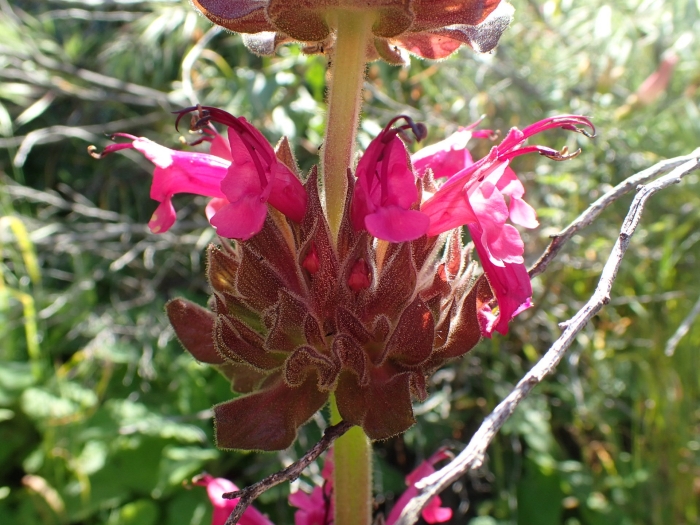California Hummingbird Sage
(Salvia spathacea)
California Hummingbird Sage (Salvia spathacea)
/
/

Scott Yarger
Public Domain
Image By:
Scott Yarger
Recorded By:
Copyright:
Public Domain
Copyright Notice:
Photo by: Scott Yarger | License Type: Public Domain | License URL: http://creativecommons.org/publicdomain/zero/1.0/ | Rights Holder: Scott Yarger | Publisher: iNaturalist | Date Created: 2017-04-19T11:52:07-07:00 |






















































Estimated Native Range
Summary
Salvia spathacea, commonly known as California Hummingbird Sage, is a perennial herb native to the coastal sage scrub and chaparral of southern and central California, thriving from sea level to 610 meters (2,001 feet). It typically grows to a height of 2-3 feet and a width of 2-4 feet. The plant features wrinkled, arrow-shaped leaves and produces striking flower spikes with dark rose-lilac flowers from March to May, which are highly attractive to hummingbirds. The foliage emits a fruity scent when brushed against or crushed.
California Hummingbird Sage is valued for its showy flowers, aromatic leaves, and ability to serve as a drought-tolerant groundcover, especially in dry shade conditions such as those found under oak canopies. It is also appreciated for its low maintenance requirements and its utility in attracting wildlife, particularly hummingbirds, to the garden. While it can tolerate a range of light conditions, from full sun to part shade, it prefers well-drained soils and can benefit from supplemental water during the blooming period to extend the flowering season. After flowering, a period of reduced watering is recommended. Salvia spathacea is resistant to browsing by deer and damage from gophers due to its strong aroma. It is important to note that this sage can spread via underground rhizomes, which should be considered when planting to avoid unwanted spread.CC BY-SA 4.0
California Hummingbird Sage is valued for its showy flowers, aromatic leaves, and ability to serve as a drought-tolerant groundcover, especially in dry shade conditions such as those found under oak canopies. It is also appreciated for its low maintenance requirements and its utility in attracting wildlife, particularly hummingbirds, to the garden. While it can tolerate a range of light conditions, from full sun to part shade, it prefers well-drained soils and can benefit from supplemental water during the blooming period to extend the flowering season. After flowering, a period of reduced watering is recommended. Salvia spathacea is resistant to browsing by deer and damage from gophers due to its strong aroma. It is important to note that this sage can spread via underground rhizomes, which should be considered when planting to avoid unwanted spread.CC BY-SA 4.0
Plant Description
- Plant Type: Herb, Subshrub
- Height: 2-3 feet
- Width: 2-4 feet
- Growth Rate: Moderate
- Flower Color: Pink, Red
- Flowering Season: Spring
- Leaf Retention: Evergreen
Growth Requirements
- Sun: Full Sun, Part Shade
- Water: Low
- Drainage: Fast
Common Uses
Bee Garden, Bird Garden, Border Plant, Butterfly Garden, Deer Resistant, Drought Tolerant, Fragrant, Groundcover, Hummingbird Garden, Low Maintenance, Rabbit Resistant, Rock Garden, Salt Tolerant, Showy Flowers, Street Planting
Natural Habitat
Native to the coastal sage scrub and chaparral of southern and central California
Other Names
Common Names: Pitcher Sage, California Hummingbird Sage
Scientific Names: , Salvia spathacea, Audibertia grandiflora, Ramona grandiflora, Audibertiella grandiflora,
GBIF Accepted Name: Salvia spathacea Greene